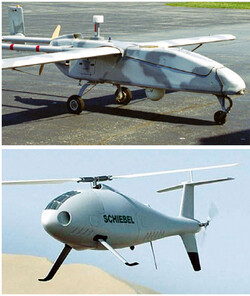hankyoreh
Links to other country sites 다른 나라 사이트 링크
Navy’s intelligence ship project crippled for several yrs.

By Lee Soon-hyuk
The Navy's intelligence gathering project on the North Korean military has been adrift for several years now.
In addition to years of failed operation due to the crashes of two unmanned aerial vehicles (UAVs) from the intelligence ships, frictions have erupted over follow-up efforts among the Navy, National Intelligence Service, and the Board of Audit and Inspection.
The project was launched in 2000 with NIS money with the intention of the ships traveling around the Northern Limit Line in the West Sea gathering sound and video information on North Korea, which would be sent to military intelligence and the NIS. At present, the first and second units are in position, while a third is under construction.
Unlike the first unit, which is strictly for audio monitoring, the second unit includes three fixed-wing SHADOW-400 UAV aircrafts made by the American company AAI to gather photographic intelligence. However, one of these aircrafts crashed during operations near Deokjeok Island in 2007, and another crashed in the waters near Pohang while on a test flight in April 2010, just after the sinking of the Cheonan.
During a parliamentary audit in September, Liberty Forward Party lawmaker Sim Dae-pyung said, "We put in three UAV sets at a cost of 26 billion won. Two of them have crashed, but with a warranty period of just one year, we haven't received a cent in compensation. The third unit has only done nine test flights without being put into position."
The crashes have indicated a need for a change in the model or improvements in the aircraft's capabilities, but arranging the necessary budget has not been easy. The NIS balked at paying for maintenance when it was already putting 300 billion won into the project for the three vessels. Finally, around 20 billion won in UAV improvement costs were included in an emergency budget for improved defense capabilities at the Five West Sea Islands that was created in the wake of the Yeonpyeong Island artillery attack in November of last year.
The Navy intelligence group operating the vessels attempted to switch out the UAVs with rotary wing "cam-copter" UAVs manufactured by the Austrian company Schiebel, but the intelligence operations department chief, an admiral identified as "S," insisted on keeping the previous models. The BAI reported gave notice of disciplinary measures to S, who countered that the audit was based on a false tipoff by the rotary wing company.
At present, the BAI and the Navy intelligence group are pointing fingers at the fixed wing company, and Admiral S, as the problem, while the NIS and Admiral S are looking at problem areas with the rotary wing company. With each model carrying its own advantages and disadvantages and a complex distribution of responsibility across the decision-making process, no clear resolution of the issue appears in sight.
Please direct questions or comments to [englishhani@hani.co.kr]
Editorial・opinion
![[Editorial] Does Yoon think the Korean public is wrong? [Editorial] Does Yoon think the Korean public is wrong?](https://flexible.img.hani.co.kr/flexible/normal/500/300/imgdb/original/2024/0417/8517133419684774.jpg) [Editorial] Does Yoon think the Korean public is wrong?
[Editorial] Does Yoon think the Korean public is wrong?![[Editorial] As it bolsters its alliance with US, Japan must be accountable for past [Editorial] As it bolsters its alliance with US, Japan must be accountable for past](https://flexible.img.hani.co.kr/flexible/normal/500/300/imgdb/original/2024/0417/6817133413968321.jpg) [Editorial] As it bolsters its alliance with US, Japan must be accountable for past
[Editorial] As it bolsters its alliance with US, Japan must be accountable for past- [Guest essay] Amending the Constitution is Yoon’s key to leaving office in public’s good graces
- [Editorial] 10 years on, lessons of Sewol tragedy must never be forgotten
- [Column] A death blow to Korea’s prosecutor politics
- [Correspondent’s column] The US and the end of Japanese pacifism
- [Guest essay] How Korea turned its trainee doctors into monsters
- [Guest essay] As someone who helped forge Seoul-Moscow ties, their status today troubles me
- [Editorial] Koreans sent a loud and clear message to Yoon
- [Column] In Korea’s midterm elections, it’s time for accountability
Most viewed articles
- 1[Column] The clock is ticking for Korea’s first lady
- 2Samsung barricades office as unionized workers strike for better conditions
- 3[Editorial] When the choice is kids or career, Korea will never overcome birth rate woes
- 4Why Israel isn’t hitting Iran with immediate retaliation
- 5[News analysis] After elections, prosecutorial reform will likely make legislative agenda
- 6[Editorial] Does Yoon think the Korean public is wrong?
- 7S. Korea, Japan reaffirm commitment to strengthening trilateral ties with US
- 8[Editorial] As it bolsters its alliance with US, Japan must be accountable for past
- 9Japan officially says compensation of Korean forced laborers isn’t its responsibility
- 10Faith in the power of memory: Why these teens carry yellow ribbons for Sewol